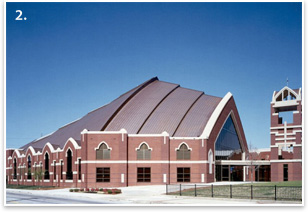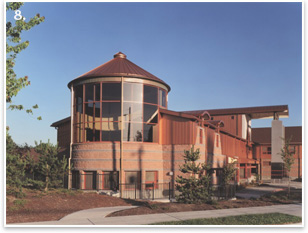
| Discovering African Identity in African-American Architecture: Part II
Summary: Can you spot African identity in architecture when the architect is African American? The topic has been a hot one for years, with some arguing that any architect of any ancestry cannot help but bring in aspects of his or her culture, while those opposed claim that site, program, and budget are overpowering influences that limit the options to express any sort of racial or ethnic personality. A large cadre of architects and interested observers quite frankly admit they wouldn’t know what to look for. Click here to read the full-text version of this article. Here’s the second of two installments on African identity. Last month’s episode ran interviews with familiar figures such as Max Bond, FAIA, of Davis Brody Bond Aedas and David Lee, FAIA, of Stull & Lee. Today’s column gives a voice to William Stanley, FAIA, and Ivenue Love-Stanley, FAIA, of the established Atlanta-based firm Stanley, Love-Stanley, and Zevilla Jackson Preston, of small but vigorous Harlem-based J-P Design, Inc., and relates the phenomenon of the late Sam Mockbee of Rural Studio. You’ll also hear from author and interior designer Sharne Algotsson, who wrote African Style, making a case for producing African identity by observing five techniques and avoiding two others.
Zevilla Jackson Preston, RA
Gail Kennard Madyun Sharne Algotsson and African Style There are other elements identified with the African Diaspora as well, including the culture mix arising from slavery in the Caribbean and the U.S., and the subsequent urban migration of the 20th century. Root elements of African heritage can still be traced throughout those transitional times in various forms of home design, site configuration, and community layout. Conclusions On a more practical plane, to express ethnic or racial identity as structure, you need opportunity. But, for black architects, the prospects to do so are, and will likely remain, overshadowed by such reality factors as site, program, budget, schedule, climate, client preference, and user preference. If a black architect is to break through this screen of practicality and integrate, visibly or concealed within the process, such cultural factors into monuments to African identity, it will take a sweeping makeover of our current business culture, which elevates cash flow above style. Even if black architects were to struggle harder to capture African culture in their work—and there’s no reason why they should have to—there’s always the pressure on any minority grouping, namely, to be accepted in the general architectural community. So they end up designing in the same stylistic vocabulary as majority firms. “You look in the magazines,” argues David Lee, FAIA, “you see what gets published and what is held up as a standard for the profession, and you have to be influenced by it.” |
||
Copyright 2007 The American Institute of Architects. All rights reserved. Home Page |
||
home
news headlines
practice
business
design
recent related
› Discovering African Identity in African-American Architecture, Part I
› Three Views on the Prospects of Increasing Diversity in the Profession
› Young African-American Women Architects Sharpen Ties to Their Communities
Next month’s column will take a look at the critical part played by the black architect’s client and patron, who has vision and opens up the prospect to do innovative work or simply demands safe but unimaginative solutions.
Did you know . . .
Film chronicles life of prolific California African American architect Paul Revere Williams. Williams is best known for his design of the theme building at Los Angeles International Airport; the Naval Base in Long Beach; and houses for dozens of movie stars including Frank Sinatra, Lon Chaney Sr., Lucille Ball, Barbara Stanwyck, and Tyrone Power. Much of his work was built on restricted sites he could not buy or consisting of properties he could not visit. The documentary Paul Revere Williams: a Legend in Architecture, is directed by Dave Kelly, Advanced Media Productions, Cal State Long Beach.
Black Enterprise Magazine recently unveiled results of its survey of companies’ efforts to promote a diverse workplace, according to an e-mail disseminated by architect Louis Smith. “No architecture firms were mentioned. In fact the industry as a whole was not mentioned,” Smith writes.
Adinkra symbols are derived from a proverb, a historical event, animal behavior, plant life, or shapes of animate and inanimate objects and are woven into cloths. They are traced to the Asante people of Ghana and Cote-d’Ivoire. Adinkra cloths, hand printed and hand embroidered, were made for and used exclusively by royalty and spiritual leaders in sacred ceremonies and rituals. American architects have adopted Adinkras as functional ornament, such as the railings in the apartment complex by Roberta Washington, FAIA, on Fifth Avenue, New York City. The examples at left are reproduced courtesy of Dr. Kwaku Ofori-Ansa. Copyright 2007 Dr Kwaku Ofori-Ansa.
Photos:
2.
Ebenezer Baptist Church, Atlanta, by architects Stanley Love-Stanley PC. Photo by Harrison Northcutt.
8. The African American Academy, Seattle, by Streeter & Associates Architects AIA, PLLC, features a circular dogon and barrel roof reminiscent of African forms. Photo by Gary Sutto/Under the Light Photography.


